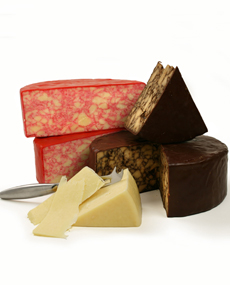 Cashel Blue: one of the great cheeses of Ireland that is readily available in the U.S. Photo courtesy iGourmet.com. Cashel Blue: one of the great cheeses of Ireland that is readily available in the U.S. Photo courtesy iGourmet.com.
|
STEPHANIE ZONIS focuses on good foods and the people who produce them.
|
|
March 2007
Updated March 2011
|
 |
Irish Cheese
Page 2: Irish Cheeses Beginning With C
This is Page 2 of a three-page article. Click on the black links below to visit other pages.
Cahill’s Farm Cheddar. These are pasteurized cow’s milk, flavored cheddars made by Marion Cahill of County Limerick, recognized as the originator of fine Irish cheese. The cheeses are visually breathtaking (see photo above), each mottled like a beautiful quarried stone from flavorings that are added before the cheeses are sealed in wax to age. The Elderberry is pinkish-purple, the Porter (shown at left) is dark brown and the Irish Whisky is golden. Any of them would make a beautiful centerpiece. Available at iGourmet.com. |
|
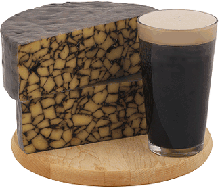
Tangy Irish Cheddar flavored with Porter is delicious with...a glass of Porter! |
Carrigaline Farmhouse Cheese. Another cheese made from pasteurized cow’s milk (from Friesian* herds), Carrigaline is a waxed cheese made in small wheels. It’s available both unflavored as well as with garlic and dried herbs. When young, the cheese is often compared to a Havarti, meaning that it’s mild, though it can become sharper as it matures. Find retail locations on CarrigalineCheese.com.
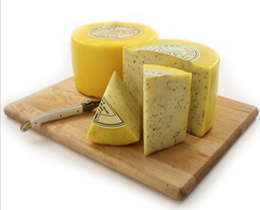
Carrigaline farmhouse cheeses, available plain or flavored with garlic and dried herbs (as shown above). |
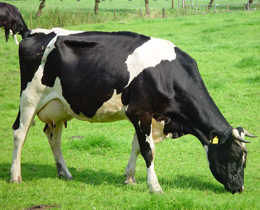 The Holstein—which today provides the classic image of a dairy cow, in various percentages of black and white. The Holstein—which today provides the classic image of a dairy cow, in various percentages of black and white. |
*The Holstein cow, now the most common breed of dairy cattle in the world (and 90% of the 10 million U.S. dairy cow population), produces a high volume of milk at an acceptable milk fat percentage, 3% to 4% milk fat. (The Jersey produces about half the volume of milk, but at 4 to 4.5% milk fat). The breed originated in what is now the Netherlands, in the two northern provinces of North Holland and Friesland, which lay on either side of the Zuider Zee. The original stock were the black and white animals of the Batavians and Friesians, migrant European tribes who settled in the Rhine Delta region about 2,000 years ago. Today in the U.K., the Friesian and Holstein breeds are considered separate, but they are also considered so similar that it is not possible to distinguish between them for statistical purposes. As a result, they are often called Holstein-Friesians.
Cashel Blue. Cashel Blue is a pasteurized cows’ milk, blue-veined cheese, made on the dairy farm of a husband-and-wife team of Jane and Louis Grubb in County Tipperary; much of the milk used comes from the Friesian herd on the farm. Like many other Irish cheeses, Cashel Blue uses non-animal rennet, so it’s vegetarian-friendly. Initial production of this cheese began in 1984, as a way to supplement farm income. Made entirely by hand from whole non-homogenized milk, it is Ireland’s original artisanal blue cheese. It has won an award in competition every year since its inception, including the Gold at the 2006 World Cheese Awards.
|
|
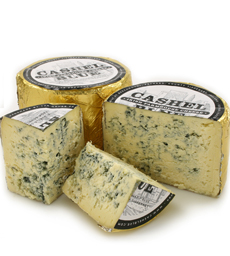
Cashel Blue Cheese: one of the great cheeses of Ireland that is readily available in the U.S. Photo courtesy iGourmet.com. |
When Cashel Blue is young, it’s firm and very crumbly in texture. As it ages, the interior becomes softer and creamier, almost buttery. Flavor changes accompany the alteration in texture, too: The piquant flavor it carries matures to a more robust, rounder taste. After about three months of aging, this cheese is known to become very potent indeed, so unless you enjoy really powerful flavors, it might be better to enjoy it when it’s somewhat younger. Where can you find it? Specialty retailers in the U.S. do carry this cheese, especially during the month of March! If you cannot find it locally, however, you can order online from iGourmet. Learn more about the cheese at CashelBlue.com.
Cashel Blue Wine Pairing
We love it when the cheesemakers recommend wines to pair with their cheeses: Who else has eaten the cheeses day after day and has tried every possible match?
With Cashel Blue, white wines are the way to go.
- When young, the cheese has a higher acidity level: The producers recommend whites such as a Gewürtztraminer when the cheese is served with an aperitif, or a Sancerre or Pinot Grigio when used in a salad.
- At medium maturity, the balanced flavor and subtle saltiness of the cheese work well with late harvest Semillons such as Sauternes, or New World Botrytis Semillons.
- When younger, the cheese will be overpowered by a Port; but a mature Cashel Blue pairs well with vintage or tawny Ports, or with Hungarian Tokaji.
For people who only drink red, look carefully for one that is not too tannic, too alcoholic or too acidic: You don’t want to overpower the subtlety of the cheese (nor do you want a flabby wine). Southern Rhone blends can work well, as do older Saint Emilions or more mature reserve Riojas from Spain.
Crozier Blue. From the makers of Cashel Blue (above), this is a pasteurized sheep’s milk blue cheese, ideal for those who enjoy deep flavors. Although it is crumbly when young, as it ages the cheese’s texture becomes creamier. It’s produced in County Tipperary, in a region noted for luxuriant pastures.
Continue To Page 3: Irish Cheese From
D To Z
Go To The Article Index Above
|
|
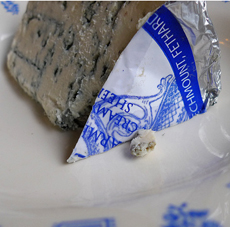
Photo courtesy Michael Hopkinsii | Flickr.com. |
Lifestyle Direct, Inc. All rights reserved. Images are the copyright of their respective owners.

|




 Cashel Blue: one of the great cheeses of Ireland that is readily available in the U.S.
Cashel Blue: one of the great cheeses of Ireland that is readily available in the U.S.



